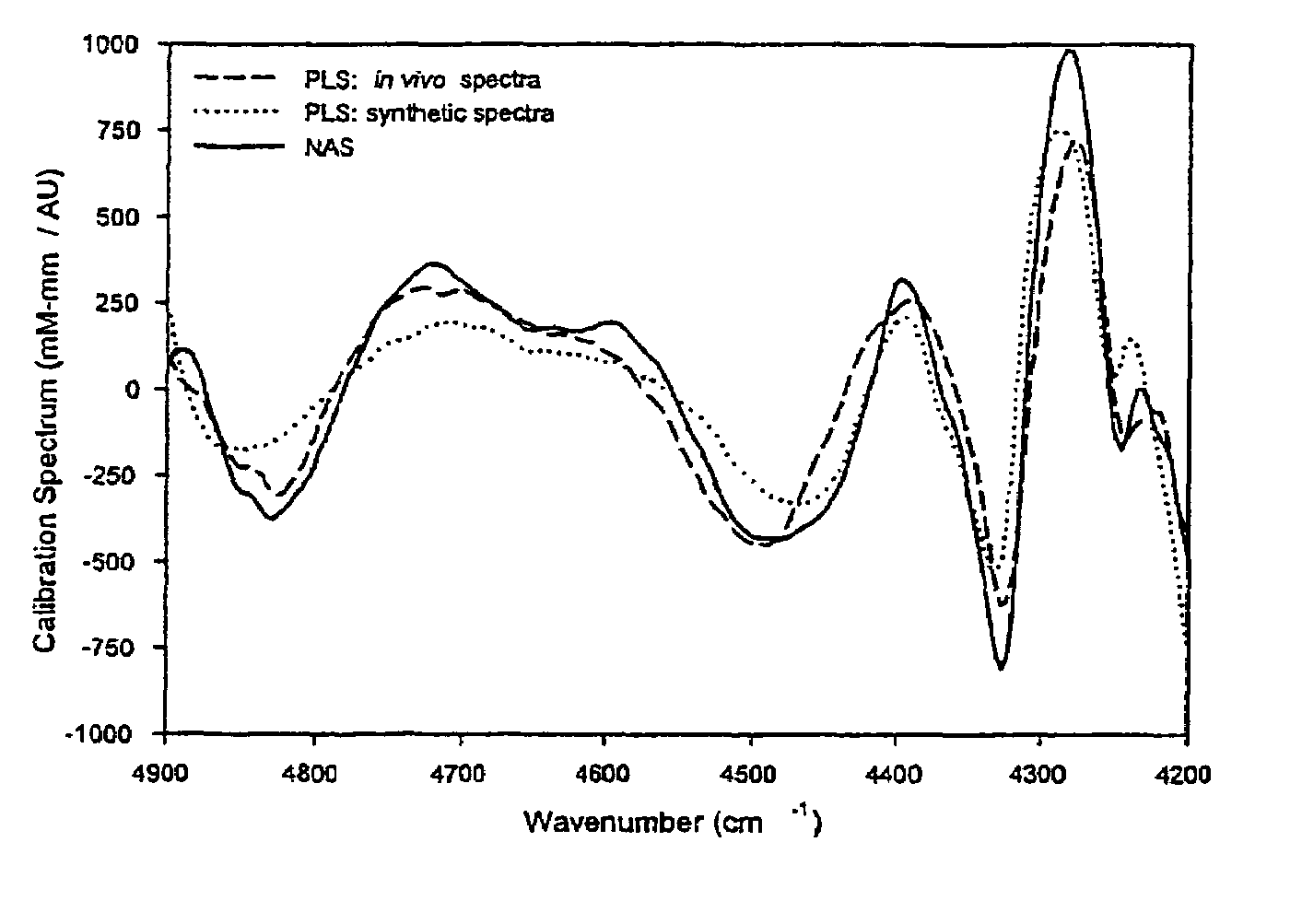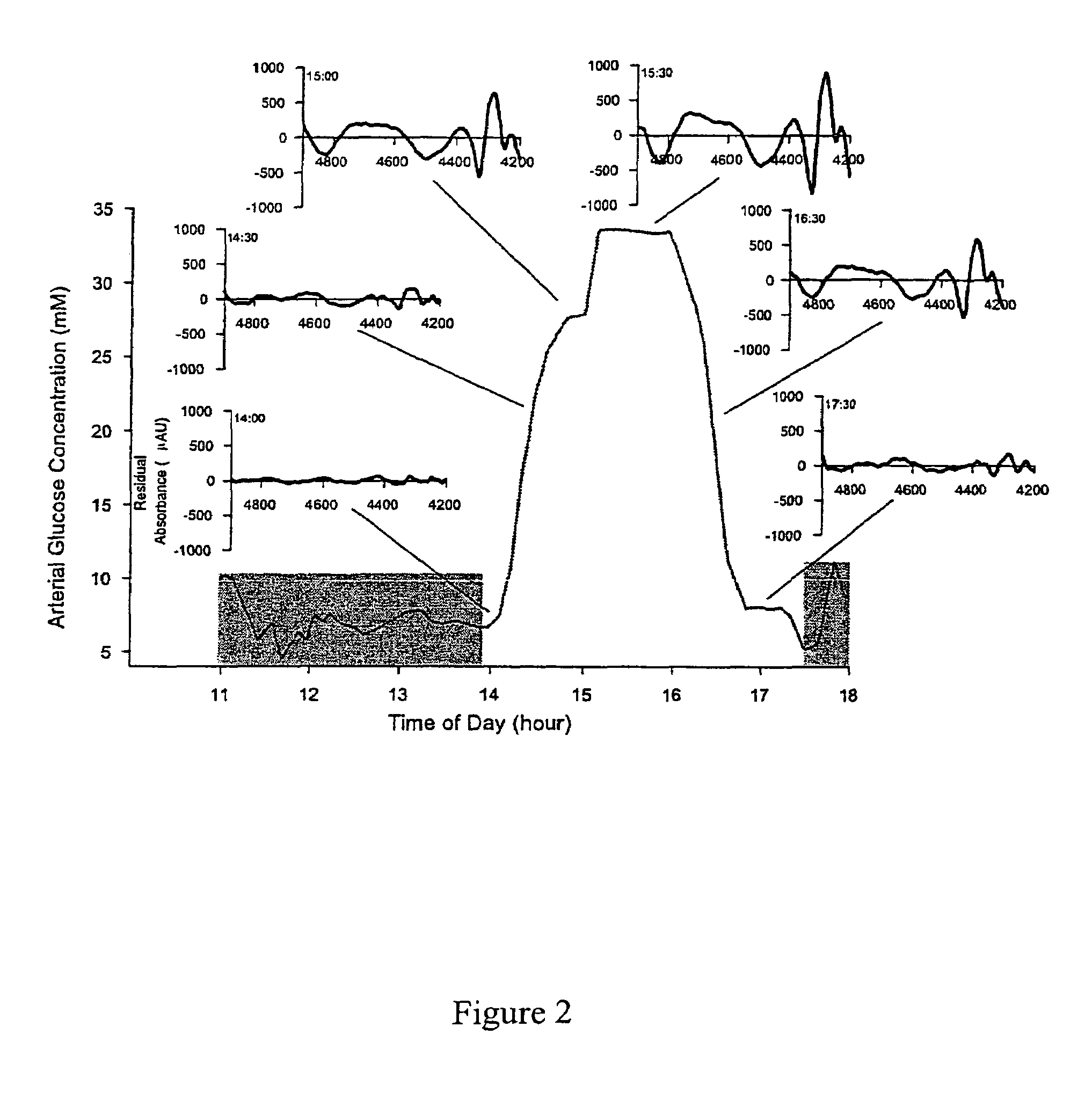Method for generating a net analyte signal calibration model and uses thereof
a net analyte signal and calibration model technology, applied in the field of in vivo spectroscopic analysis, can solve the problems of increased financial burden, premature death, pain and suffering, and difficulty in obtaining blood samples several times daily, and achieves the effects of reducing the cost of diabetes, and improving the accuracy of the calibration model
- Summary
- Abstract
- Description
- Claims
- Application Information
AI Technical Summary
Problems solved by technology
Method used
Image
Examples
example 1
Generation of an in vivo Net Analyte Signal Calibration Model for Glucose in a Lab Rat as Tested Above
[0081]Using the data collected from the experimental procedure described above, an in vivo net analyte signal calibration model for glucose in the lab rat was generated. First, the time profile of arterial glucose concentration in the lab rat over the course of the experiment is depicted in FIG. 1. The lower, shaded regions on FIG. 1 indicate the times during the course of the experiment when the glucose concentration was held substantially constant and the times from which the obtained spectra were used to form the baseline background spectra (11:00-13:50 and 17:30-18:00). The latter set of shaded spectra were included in the background calculation of the baseline factors in order to correct for long term drift in the spectroscopy system. During the period from 13:00-13:45, the fiber optic clamp was repositioned on the animal between each scan in order to account for possible varia...
example 2
Use of the Model to Measure a Predicted Concentration
[0085]The net analyte signal of glucose generated in Example 1 above was used to calculate predicted concentrations of glucose at selected periods during the course of the experimental procedure.
[0086]The glucose concentration was calculated using the following mathematical model:
[0087]Cglucose=βglucose·Al+C_b
Where Cglucose is the concentration of glucose in the animal, βglucose is the glucose calibration vector from the net analyte signal, A is the absorbance spectrum measured for the rat skin, λ is the optical path length, which is approximately 0.7 mm in this experiment, and Cb(bar) is the mean concentration of glucose in the set of baseline spectra used to generate the net analyte signal. The average glucose concentration is ca., 7 mM for the baseline spectra used in this experiment.
[0088]The results of this calculation are indicated in FIG. 4, wherein the open circles represent the spectra used in the calculation of the backg...
example 3
Generation of in vivo PLS Multivariate Calibration Model
[0090]The net analyte signal of glucose generated in Example 1 was also used to evaluate the analytical significance of a classical partial least squares regression calibration model obtained from the same spectral data obtained in the experimental procedure.
[0091]A partial least squares regression calibration model was generated from the data collected in the foregoing experiment. A set of 54 randomly selected spectra were removed from the data set and set aside for an independent measure of the standard error of prediction after the calibration was constructed. All remaining spectra, (approximately 306) were used to build the partial least squares calibration model. The number of factors was chosen by performing 50 repetitions of a randomly selected leave-one-third-out cross validation of the calibration spectra after mean centering. The average standard error of cross validation (SECV) from the 50 repetitions is shown in FIG...
PUM
 Login to View More
Login to View More Abstract
Description
Claims
Application Information
 Login to View More
Login to View More - R&D
- Intellectual Property
- Life Sciences
- Materials
- Tech Scout
- Unparalleled Data Quality
- Higher Quality Content
- 60% Fewer Hallucinations
Browse by: Latest US Patents, China's latest patents, Technical Efficacy Thesaurus, Application Domain, Technology Topic, Popular Technical Reports.
© 2025 PatSnap. All rights reserved.Legal|Privacy policy|Modern Slavery Act Transparency Statement|Sitemap|About US| Contact US: help@patsnap.com



